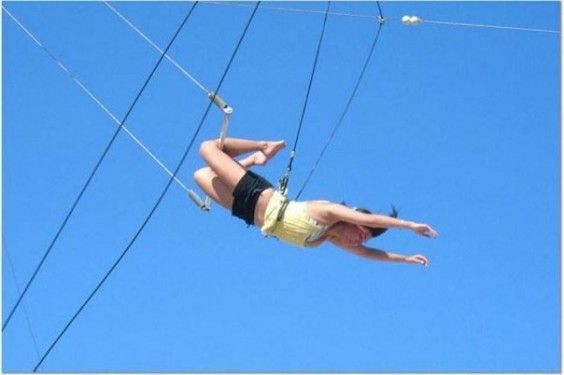For anyone who ever wanted to run away and join the circus, trapeze classes offer a vacation from standard gym fare. Based on flying trapeze routines, these lessons help build muscle and provide a full body workout. With both classroom-based methods and a high-flying, circus-like version, there’s an acrobatic option for every fitness level and taste for adventure.
High-Flying Fitness — The Need-to-Know Trapeze classes are based on the famed circus act, and just like real acrobatic flyers, participants swing, hang, and even attempt catches. Unlike professional trapeze artists, though, learners are kept closer to the ground or get to wear harnesses and fly over a safety net. While traditional trapeze classes are widely available for the circus wannabes, trapeze has also been reinterpreted as a group fitness workout. In 2008, Cirque du Soleil and Reebok teamed up to develop a one-hour, in-gym version called Jukari Fit to Fly. These classes have a maximum of 12 students and keep participants on solid ground. As for their effectiveness as a fitness routine, they offer cardio, core conditioning, strength training, and balance. Because of the group dynamic, participants are kept moving the entire time. Meanwhile, lifting and maneuvering body weight builds and strengthens muscle. Flying trapeze focuses on many of the same fitness goals as the gym-based class, working the upper body, core, and lower body. In these versions, lessons are typically longer and limited to fewer students with more instructors, though the numbers vary from school to school. In flying trapeze classes, students are instructed on the ground before heading into the air and wear safety harnesses from the moment they step foot off the floor.
Flip Out — Your Action Plan
Trapeze courses are available from introductory to advanced levels, and beginners typically swing on the trapeze, hook their legs over the bar, possibly attempt a catch, and likely take at least a few tumbles into the net. Thanks to the low instructor-to-student ratio, classes are highly customizable and most people are able to participate regardless of fitness level. To take a class, students need only be able to hold their own body weight, though individual schools may have additional age or weight limits. And in the mind-over-matter category, trapeze may be just the ticket to defeating a fear of heights. As for safety, most trapeze classes assure participants that their courses are perfectly risk-free as long as instructions are followed, though many still require a waiver. Old upper body injuries could also be problematic when flipping, flying, and hanging on tight, so run ‘em by an instructor before heading vertical. Like any new fitness class, stretch it out (focusing especially on shoulders and upper body), and take it easy— at least at first!
Beginners’ Tips
Some beginners’ tips from Peter Gold, 25-year coach, flying trapeze artist, and owner of Trapeze Experience. “Flying trapeze is the real thing. It’s the same one we use in the circus, and it is an intense workout for mind, body, and spirit.”
- It’s very beginner friendly; you don’t have to be in great shape in order to get out and start enjoying it, but the heavier someone is, the more difficult its going to be.
- Because of the extremely controlled environment of trapeze, it is much safer than most other sports. Of course, you can’t eliminate all possible sports injuries, so when in doubt, sit it out.
- If people have rotator cuff or shoulder injuries that aren’t rehabilitated, I don’t recommend they do trapeze. If you’re fairly active— go to the gym or ride a bicycle a couple times a week— you can do trapeze. Otherwise, consult your physician.
- It’s a fantastic activity for families. Not only can children enjoy it at their level, but adults can enjoy it at their own level, too, and you have a special shared experience.

